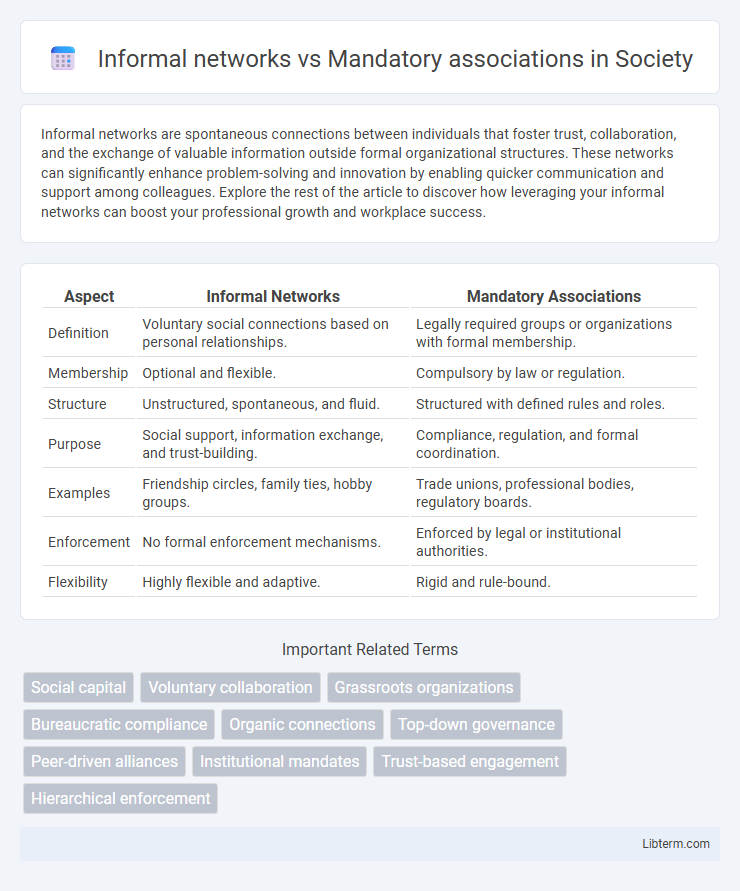Informal networks are spontaneous connections between individuals that foster trust, collaboration, and the exchange of valuable information outside formal organizational structures. These networks can significantly enhance problem-solving and innovation by enabling quicker communication and support among colleagues. Explore the rest of the article to discover how leveraging your informal networks can boost your professional growth and workplace success.
Table of Comparison
| Aspect | Informal Networks | Mandatory Associations |
|---|---|---|
| Definition | Voluntary social connections based on personal relationships. | Legally required groups or organizations with formal membership. |
| Membership | Optional and flexible. | Compulsory by law or regulation. |
| Structure | Unstructured, spontaneous, and fluid. | Structured with defined rules and roles. |
| Purpose | Social support, information exchange, and trust-building. | Compliance, regulation, and formal coordination. |
| Examples | Friendship circles, family ties, hobby groups. | Trade unions, professional bodies, regulatory boards. |
| Enforcement | No formal enforcement mechanisms. | Enforced by legal or institutional authorities. |
| Flexibility | Highly flexible and adaptive. | Rigid and rule-bound. |
Understanding Informal Networks
Informal networks consist of personal relationships and social connections that develop naturally within an organization, facilitating communication and collaboration beyond formal structures. These networks enable employees to share information quickly, solve problems creatively, and build trust, often leading to increased innovation and job satisfaction. Understanding informal networks helps leaders identify key influencers and leverage social dynamics to improve organizational effectiveness.
Defining Mandatory Associations
Mandatory associations are formal organizational structures required by law or policy that define specific roles, responsibilities, and interactions between entities, ensuring compliance and standardized operations. These associations typically involve regulated teams, professional bodies, or industry groups that enforce rules and maintain accountability within a sector. Unlike informal networks, mandatory associations provide a legally binding framework that supports governance and coordinated decision-making processes.
Key Differences Between Informal and Mandatory Associations
Informal networks consist of voluntary, flexible relationships based on personal interests and social interactions, while mandatory associations are formally established, structured groups with specific purposes and regulations. Informal networks thrive on trust and spontaneous communication, contrasting with the rule-bound, goal-oriented nature of mandatory associations. The key difference lies in the level of obligation and formality, where informal networks promote organic bonding and mandatory associations enforce participation and compliance.
Advantages of Informal Networks
Informal networks enhance workplace communication by fostering trust and collaboration beyond formal hierarchies, enabling faster problem-solving and innovation. These networks support knowledge sharing and social support, which increase employee engagement and job satisfaction. Unlike mandatory associations, informal networks adapt organically, creating resilient connections that improve organizational agility.
Benefits of Mandatory Associations
Mandatory associations ensure consistent industry standards, enhancing regulatory compliance and fostering trust among stakeholders. They facilitate collective bargaining, enabling members to achieve better terms and protections that individual entities might not secure independently. These associations also provide structured platforms for professional development, resource sharing, and unified advocacy, driving sector-wide growth and stability.
Challenges of Informal Networks
Informal networks often face challenges such as lack of structure, which can lead to inconsistent communication and unequal access to information among members. These networks may struggle with accountability issues, making it difficult to enforce decisions or maintain confidentiality. Unlike mandatory associations, informal networks lack formal mechanisms for conflict resolution and resource allocation, hindering their effectiveness in achieving collective goals.
Limitations of Mandatory Associations
Mandatory associations often face limitations such as reduced flexibility and lower employee engagement because they impose fixed structures that can stifle creativity and innovation. These associations may hinder spontaneous collaboration, which is a key advantage of informal networks where relationships form naturally based on trust and shared interests. The rigidity of mandatory associations can also lead to resistance or compliance without genuine commitment, reducing overall organizational effectiveness.
Impact on Organizational Culture
Informal networks foster spontaneous communication and trust, significantly enhancing collaboration and innovation within organizational culture. Mandatory associations, structured by formal rules and roles, reinforce hierarchy and compliance, which can limit flexibility but ensure alignment with organizational goals. The interplay between these networks shapes employee engagement and the adaptability of the organizational culture.
Influence on Collaboration and Innovation
Informal networks foster organic collaboration and innovation by enabling spontaneous knowledge sharing, trust-building, and diverse idea exchange beyond formal structures. Mandatory associations often operate through formal hierarchies and predefined roles, which can streamline communication but may limit creative freedom and slow innovation due to rigid protocols. Research shows organizations leveraging informal networks achieve higher innovation rates and enhanced problem-solving through dynamic, cross-functional interactions.
Choosing the Right Model: Factors to Consider
Choosing the right model between informal networks and mandatory associations depends on factors such as organizational culture, communication needs, and desired flexibility. Informal networks foster collaboration and creativity through spontaneous interactions, while mandatory associations ensure structured processes and accountability. Assessing goals, employee autonomy, and the nature of tasks helps determine the optimal balance for effective collaboration and productivity.
Informal networks Infographic

 libterm.com
libterm.com